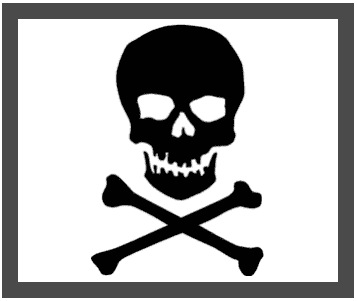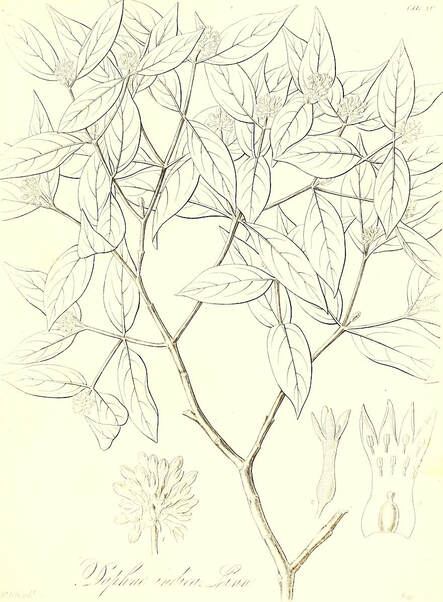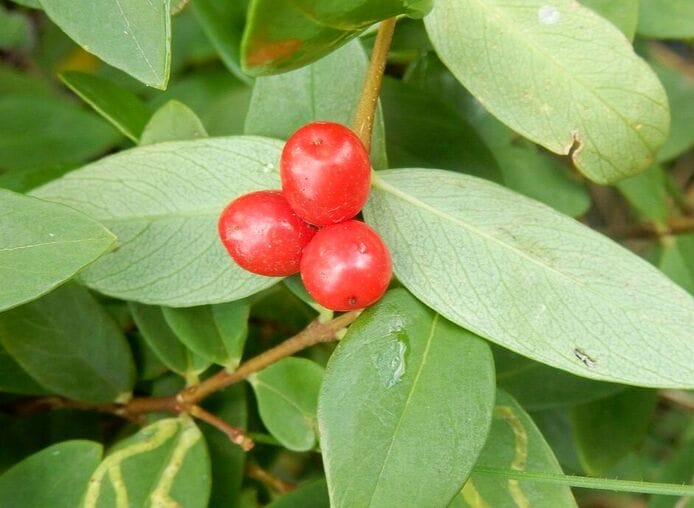Wikstroemia, Le Ge Wang 了哥王Indian Stringbush, Small-Leaf SalagoLe Ge Wang, Pu Yin, Liao Ge Wang (TCM) |

|

|
 Wikstroemia indica (as Daphne indica)
Wikstroemia indica (as Daphne indica)The Botany of Captain Beechey’s Voyage, Hooker et al., 1825
 Wikstroemia indica
Wikstroemia indicaPhoto by Peter Woodard) (Wikimedia)
Botanical name:
Wikstroemia indica (syn. W. viridiflora, Daphne indica)
Parts used:
Root, Root-bark
Temperature & Taste:
Cold, dry. Bitter. Toxic
Classification:
B. Clear Heat and Toxin
Uses:
1. Clears Heat, Resists Toxin:
-Sore Throat, Tonsillitis
-Lung-Heat Cough, Bronchial Asthma
-Whooping Cough, Pneumonia
-Dysentery
-Boils, Abscesses, Carbuncles, Toxic Sores with pus (internally and topically)
–Acute Mastitis, Cellulitis (internally and topically)
-Insect and Snake Bites
2. Clears Heat and Damp, Promotes Urine:
-Edema, Nephritis
-Gout, Arthritis, Rheumatic Arthritis
3. Clears Heat, Resolves Masses:
-Scrofula, lymphadenitis
-Cirrhosis
-Trauma, Bruising
-Leprosy
-Tumors; Cancer (Lung, Liver, Cervical Cancer, Lymphosarcoma topically for Skin Cancer) (Glycosides, Lignans, Quinones have shown anti-cancer effect)
-Leaf and stem are also used in Cancer therapy
4. Kills Worms:
-various Worms
-Schistosomiasis
Dose:
It is decocted for longer than usual, at least 3 hours but up to 5 hours when full doses are used.
Decoction: 3–12 grams (fresh 9–15 grams)
Tincture (1 in 10 in 50% alcohol): 1–4 mls.
Used topically as a paste, in compresses, liniments etc.
Comment:
In China an injection is prepared from Wikstroemia root bark which is used for Pneumonia, bronchitis, tonsillitis, lymphadenitis, mumps, acute mastitis, cellulitis and rheumatoid arthritis.
Main Combinations:
1. Tonsillitis, Wikstroemia with Isatis Folium Da Qing Ye, Lonicera Jin Yin Hua, Forsythia Lian Qiao
2. Gout, Arthritis, Wikstroemia with Moghania Yi Tiao Gen
3. Pneumonia, Wikstroemia with Isatis Radix Ban Lan Gen, Gardenia Zhi Zi
4. Cirrhosis, Wikstroemia with Xue Fu Zhu Yu Tang (a formula)
5. Cancer: Turmeric and Wikstroemia have synergistic effects in nasopharyngeal cancer.
6. Cervicitis, a 10% decoction is used as a vaginal douche.
Major Formulas:
Cautions:
1. Toxic in overdose. Avoid long-term use. It must be long decocted (3–5 hours) to reduce toxicity.
2. Not used during Pregnancy or breastfeeding.
3. Avoid in people with Coldness or those who are weak.
Toxicity:
Overdose causes Nausea, Vomiting, Abdominal pain, Diarrhea, swelling of the Throat, difficult Respiration which may lead to unconsciousness. Cummulative toxicity may induce Vomiting and Diarrhea.
Antidotes:
1. Gastric lavage, then drink strong tea and take charcoal or tannin.
2. Strong decoction of Cinnamon and Licorice.
3. Decoction of Platycodon Jie Geng with Milk or Egg White
4. Calamus (Shi Chang Pu) 30 grams, Black Soybean (Hei Dou) 15 grams, Phragmatis Lu Gen 120 grams, Imperata Bai Mao Gen 30 grams, Lonicera Jin Yin Hua 15 grams. (Chinese Medical Herbology and Pharmacology, Chen and Chen, 2001)
